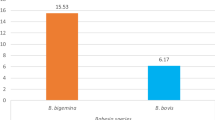Summary
The importance of babesiosis in livestock in China is discussed and mainly focused on bovine and equine babesiosis. Babesiosis is still one of the most important diseases affecting livestock and has caused great economic loss. Nine species ofBabesia have been recognized in livestock:B. bigemina, B. bovis, B. major, B. motasi, B. ovis, B. perroncitoi, B.trautmanni, B. equi (Theileria equi), B. caballi. The distribution ofBabesia follows the distribution of the tick vectors. The main vectors of bovine babesiosis are the one-host tickBoophilus microplus and the three-host ticksRhipicephalus haemaphysaloides haemaphysaloides, Haemaphysalis punctata andHaemaphysalis longicornis. Bovine babesiosis has caused significant losses in milk and meat from cattle in most parts of China. The disease is also a barrier to improving productivity of local cattle by cross-breeding due to the high mortality of genetically superior but highly susceptible cattle, especially dairy cattle, imported fromBabesia-free areas.Dermacentor nuttalli is the major vector of equine babesiosis and the tick is distributed in almost all parts of North China. Outbreaks of equine babesiosis have not been very common, but in some districts the disease has seriously affected horses, donkeys and mules.
Similar content being viewed by others
References
Bai Q., Liu G., Zhou J. &Zhang L. (1990). Studies on isolation and preservation of a single species of haemotocytozoon in bovine: Isolation of pure seed strain ofBabesia bovis.Chinese Journal of Veterinary Science and Technology,7, 10–11.
Bai Qi, Liu Guangyuan &Hang Ganfeng (1995). Research on the ability of various developmental stages ofDermacentor nuttalli to transmitBabesia caballi.Acta Veterinaria et Zootechnica Sinica,26 (1), 47–52.
Chen Deming, He Xichi, Liufasheng, Huangyonghe & Yang Chenvan (1980). Investigation on the diseases of domestic animals in Ganzi, Sichuan.Ganzi Veterinary Service, 130–144.
Cheng Shouren (1984). Babesiosis of buffalo caused by a combination ofBabesia bigemina andBabesia bovis. Hubei Journal of Veterinary and Animal Husbandry,4, 23–24
Cheng Zhenhuan, Zhou Junyin, Yin Shixing &Bai Qi (1988). ExperimentalBabesia bigemina infection.Chinese Journal of Veterinary Science and Technology,8, 38–39.
Deng Ganzhen &Liu Zhonglin (1993). Study on latex agglutination test for the diagnosis of babesiosis in buffalo.Journal of Huanzhong Agricultural University,12(3), 265–274.
Jiang Fuze &Bi Yunlong (1959). A report on the bovine piroplamosis in Hunming1, 23–26.
Li Dechang (1980). Investigation on the vector ticks of equine babesiosis in Jilin Province.Proceedings of the Second National Symposium on Veterinary Parasitology.304.
Li Dechang (1986). Studies on the distribution of the vector ticks of equine babesiosis in China.Proceedings of the First Symposium of the Chinese Society of Veterinary Parasitology, Beijing, 196.
Liu Junhua & Zhangxing (1980). Complement fixation test for equine babesiosis.Proceedings of the Second National Symposium on Veterinary Parasitology, 305–307.
Liu Zhongling (1963). An investigation of piroplasmosis in Wahan.The Hubei Journal of Veterinary and Animal Husbandry,2, 34–38.
Liu Zhongling, Zhang Guangdi, Ma Lihua &Huang Jifen (1986). An investigation of babesiosis in buffaloes in Hubei province.Acta Veterinaria et Zootechnica Sinica,17(1), 49–54.
Liu, Z. L., Ma, L. H., Gao, X. S., Chen, X. J., Yan, D. J. & Wan, S. Y. (1988). Babesiosis in Hubei Province: Experimental transmission ofBabesia bigemina andBabesia bovis byRhipicephalus haemaphysaloides haemaphysaloides. Acta Veterinary et Zootechnica Sinica, 173–178.
Liu Zhongling, Zhaojunlong, Ma Lihua &Yao Baoan (1993). Study on babesiosis of buffalo in Hubei province of China.Anaplasma and Babesiosis Network Newletter,2, 2.
Lu Jiangtai, Lichangqing & Yin Shixing (1978). Studies on the biological characteristics ofDermacentor nuttalli the vector of equine babesiosis.Annals of Lanzhou Veterinary Research Institute, 281–287.
Lu Wenxiang, Lu Wenshun, Zhang Qicai, Luo Jianxun, Yin Hong &Dou Huifang (1995). Survey of the species of tick-borne haemoprotozoan of cattle and feature in China.Chinese Journal of Veterinary Sciences and Technology,25(8), 13–16.
Lu, W. S., Yin, H., Lu, W. X., Yu, F., Zhang, O. C. &Dou, H. F. (1988). Discovery ofBabesia major from cattle and confirmation of its transmitting vector tick in China.Chinese Journal of Veterinary Science and Technology,12, 11–14.
Lu, W. S., Yin, H., Yu, F., Lu, W. X., Zhang, Q. C. &Dou, H.F. (1989). Studies on the transmission ability ofBabesia bovis andB. bigemina byBoophilus microplus.Chinese Journal of Veterinary Science and Technology,7, 10–11.
Lu, W. S., Yin, H., Lu, W. X., Zhang, O. C., Yu, F. &Dou, H. F. (1990). Experimental studies on the transovarial transmission ofBabesia major from bovine by tickHaemaphysalis longicornis.Chinese Journal of Veterinary Science and Technology,6, 5–6.
Lu, W. S., Yin, H., Luo, J. X., Lu, W. X., Zhang, Q. C. & Dou, H. F. (1992). Discovery ofBabesia major in Xinjiang.Symposium of the Third Meeting of Chinese Society of Veterinary Parasitology, 220.
Luo Jinzhong (1980). Investigation of equine babesiosis in Ganca County.Proceedings of the Second National Symposium on Veterinary Parasitology, 302–303.
Uilenburg, G. (1995). International collaborative research: significance of tick-borne haemoparasitic diseases to world animal health.Veterinary Parasitology,57, 19–41.
Wang Changji (1993). Bovine piroplasmosis. In:The diseases of Domestic Animals in China, edited by Division of Veterinary and Animal Husbandry, Minstry of Agriculture, Academic Press, 381–390.
Wang Changjiang &Zhong Ling (1989). Studies on diagnosis of babesiosis in buffalo with indirect fluoresent antibody test,Journal of Huanzhong Agricultural University,4, 373–379.
Wu Jiansan &Xie MingQuan (1996). Development and application of DNA probe forBabesia bovis.Acta of Parasitology and Acarology,3, 2.
Yang, P. & Wang, X. W. (1964). Investigation on the haemoprotozoans in Guizhou Province.Symposium of the First National Meeting on Research of Veterinary Parasitology, 351–355.
Yin Hong, Lu Wenshun, Luo Jianxun, Lu Wenxiang, Zhan Qicai & Huifang Dou (1996) Experiments on the transmission ofBabesia major andBabesia bigemina byHaemaphysalis punctata. Veterinary Parasitology, in press.
Zhang Mu (1959). Treatment of dairy cattle babesiosis in Huguang plant.Animal Husbandry and Veterinary Medicine,10(6), 267–270.
Zhang Minqian & Fen Zeguang (1959). Diagnosis and treatment of dairy cattle in Kunming.Chinese Journal of Veterinary Medicine, 33–35.
Author information
Authors and Affiliations
Rights and permissions
About this article
Cite this article
Yin, H., Lu, W. & Luo, J. Babesiosis in China. Trop Anim Health Prod 29 (Suppl 4), 11S–15S (1997). https://doi.org/10.1007/BF02632908
Issue Date:
DOI: https://doi.org/10.1007/BF02632908




